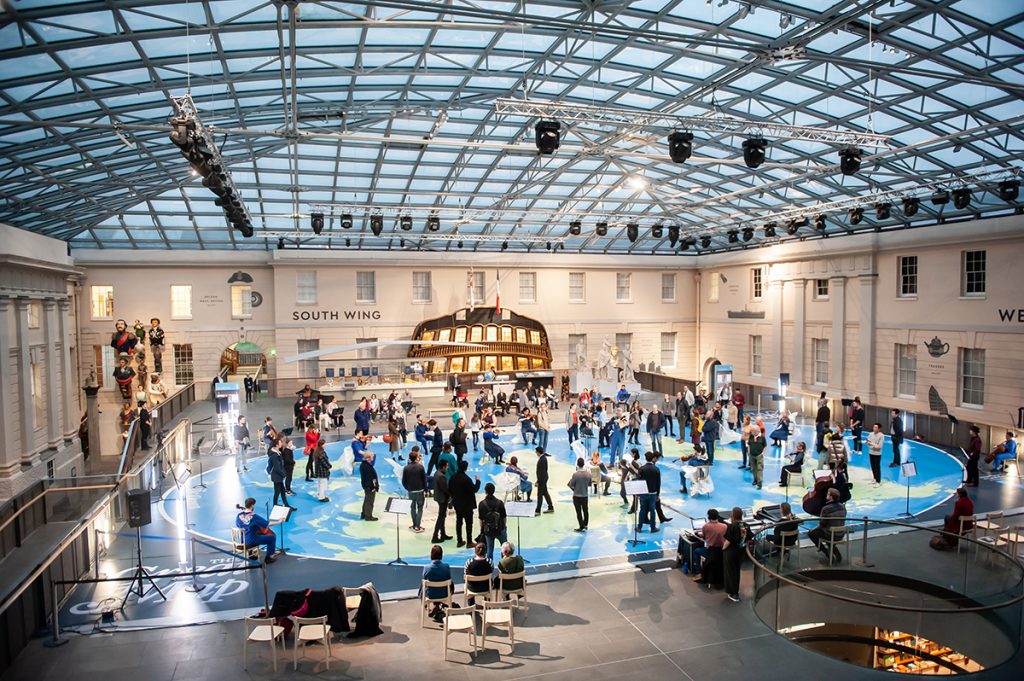Hollie Harding is the first composer to create an immersive spatial performance using bone-conducting technology. She talks to Quays Life about her new work Melting, Shifting, Liquid World being performed at Stoller Hall.

Can you tell us a bit about the show?
Hollie: “The show, curated by Nic Pendlebury, Head of Strings at Trinity Laban Conservatoire of Music and Dance, and performed by Trinity Laban String Ensemble, is called A Change of Season and will feature a re-imagined performance of Vivaldi’s Four Seasons directed by Anna Morrissey, with Production Design by Carla Goodman, as the first half. The second half of the concert features my immersive piece Melting, Shifting, Liquid World which is a stand alone piece and is not based on the Vivaldi, but instead explores ideas relating to the spatialisation of sound, of performers and the audience, and draws on data and sounds relating to climate change”.
Looking at climate change and the seasons as they may become, do you see the piece as a call to action?
Hollie: “I would describe the piece as a collaborative exploration of some of the issues relating to climate change, with a particular focus on the rising temperature and increased pollution of the oceans. When working on the piece I collaborated with many cross-discipline contributors including poet, Maura Dooley who wrote the eco-political poem that can be heard at the end of the work Still Life with Sea Pinks and High Tide (Blood Axe Books 2016), scientist Dr Hayley Evers-King who contributed a text that is included in the programme and helped me to work with and access Ocean Monitoring Indicators that I used to generate some of the sounds, and with a team of wonderful costume designers who created costume using repurposed and recycled materials, woven and patched to create new fabrics. The intention was to stimulate thought and discussion through creating the work with this team”.

How important is it for you to produce work that speaks to social issues and why do you think music is such an effective medium for encouraging change?
Hollie: “Music is a social art form and as such it feels very natural to me, for that to expand to influence the creative processes as well as the performative. Music also often carries wider messages, be those programmatic, narrative, political, physical – I don’t necessarily think it is a requirement to make work that engages with the outside world – but engaging with society and issues outside of just ‘sounds’ can often be inspiring to me”.
The piece grew out of your PhD. How does it push the boundaries and add something new to classical music?
Hollie: “The piece explores new technology, bone-conduction headsets, to create a multi-layered sound world that the audience can move around and within. This also means that sounds can happen very close to, far from and all around the listener. I love the idea of offering audience a more active participatory listening experience. I am certainly not the first composer to engage with this type of immersive spatial set-up but I am the first to try it with this technology”.
What are bone-conduction headphones and what is the idea behind the audience wearing them during the performance?
Hollie: The bone-conduction headsets, provided by Shokz headphone company, are a really innovative piece of technology. Transducers send mini vibrations through the cheekbones and deliver sound directly to the inner ear, bypassing the eardrum. This leaves the ears open to experience the surrounding environment. In this case the surrounding environment contains sounds from the string ensemble and electric viola, so there are many layers to the sonic experience”.
What is the importance of the piece being performed in the atrium?
Hollie: “The piece was originally written to be performed at the National Maritime Museum on their iconic Great Map. The space has a very particular acoustic – it is very resonant and reverberant but also very open. The atrium acoustic shares some of these sound qualities, so it felt to be a good fit!”
Performers and audience are free to move during the piece. Are there any rules for the audience or anything they need to be aware of?
Hollie: “The audience should feel able to move or sit as they wish during the performance. At times the string players will also be moving around in the space, so the only thing to be mindful of is not bumping into anyone”.
Is there anything you would like to say about the performance?
Hollie: “It has been fantastic to have the opportunity to have this piece performed again as part of a UK tour. It wouldn’t have been possible without the incredible support of Trinity Laban, Nic Pendlebury, the wonderful student performers and production team. I hope that you will enjoy the show!”
Trinity Laban String Ensemble: A Change of Season is at Stoller Hall on March 23 2022 as part of its Sounds of Nature Programme.





